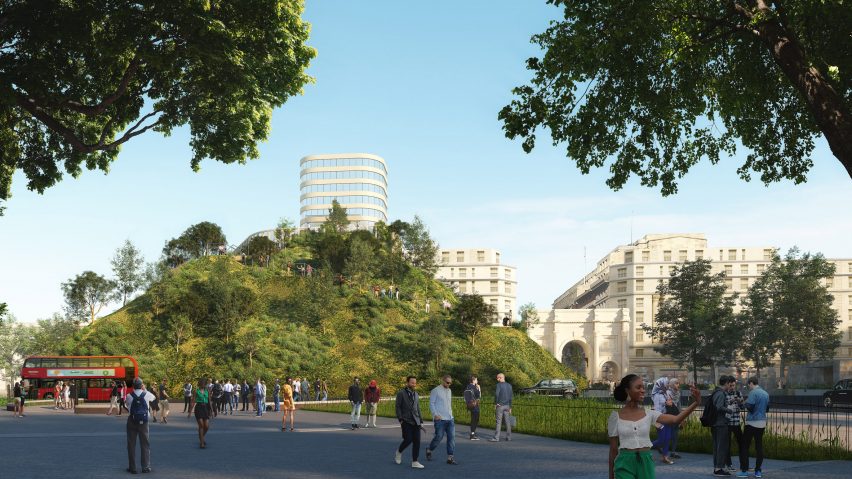MVRDV has revealed visuals of Marble Arch Mound, a temporary landscaped viewpoint that will be built in central London to attract people back to the Oxford Street shopping district following the coronavirus pandemic.
The 25-metre-tall structure will open in July and provide "rare views" of Marble Arch – a 19th-century triumphal arch designed by architect John Nash – as well as Hyde Park.
It was designed by Dutch architect MVRDV as a nod to the history of the site, which was previously part of the adjacent park before being isolated and adapted into a large traffic island in the 1960s.
"This project is a wonderful opportunity to give an impulse to a highly recognisable location in London," says MVRDV founding partner Winy Maas.
"By adding this landscape element, we make a comment on the urban layout of the Marble Arch, and by looking to the site's history, we make a comment on the area's future," he added.
"Can this temporary addition help inspire the city to undo the mistakes of the 1960s, and repair that connection?"
MVRDV was commissioned to design Marble Arch Hill by Westminster City Council in response to the impact of the coronavirus pandemic on Oxford Street, a busy shopping area close to Marble Arch.
The installation is hoped to encourage visitors to return to the street after the government's lockdown restrictions are eased by creating renewed interest in the area.
Once complete, it will bear resemblance to MVRDV's proposal for the 2004 Serpentine Pavilion, which was designed as a huge artificial mountain around the Serpentine Gallery but never realised due to costs.
Marble Arch Hill will be constructed using scaffolding, which will form a hollow base upon which layers of plywood and soil will then be laid.
The soil will be used to grow grass across the structure, while also holding large planters that will be filled with trees.
As the installation is temporary, MVRDV's goal is for it to produce as little waste as possible. The scaffolding will therefore be easily disassembled and reused, while the layers of wood, soil, grass, and trees will all be reused across nearby gardens and parks.
Once complete, a single continuous route will wind up and around the hill to guide visitors to its peak. Visitors will then descend back down via a hall within its hollowed-out centre, which will be used for events and exhibitions.
MVRDV is an architecture studio founded in Rotterdam in 1991 by Maas, alongside Jacob van Rijs and Nathalie de Vries. The studio previously made use of scaffolding to create a temporary installation for the Stairs to Kriterion in Rotterdam in 2016.
Other recent projects by the studio include the world's "first publicly accessible art depot", also in Rotterdam, which is wrapped by a facade of mirrored panels.
Visualisations are by Antonio Luca Coco, Angelo La Delfa and Luana La Martina, courtesy of MVRDV.
Project credits:
Architect: MVRDV
Founding partner in charge: Winy Maas
Director: Gideon Maasland
Design team: Gijs Rikken, Sanne van Manen, Joanna Wirkus and Paulina Kurowska

